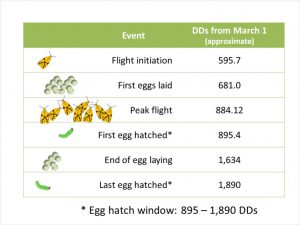Based on our degree-day (DD) model for Sparganothis fruitworm, first eggs hatched at about 900 DD (see chart). As of July 02, Sparganothis

Sparganothis degree-day model benchmarks
has accumulated 1,212 DD (using April15 as biofix). This indicates that most eggs should have hatched by now and fruit is susceptible to infestation. Most beds should soon be out of bloom. Thus, if trap counts have been high, then a post-bloom application might be necessary. Growers should consider treatment in the next few days (as soon as bees are removed) to prevent damage to berries. Your best post-bloom options are Diazinon, Altacor, or Delegate.
